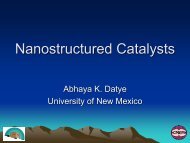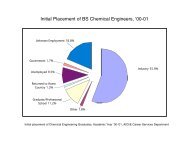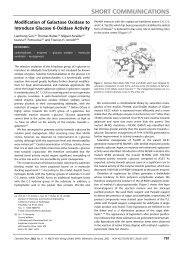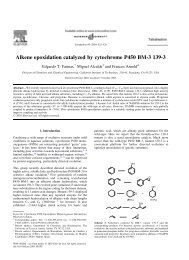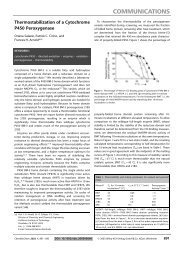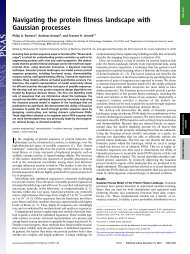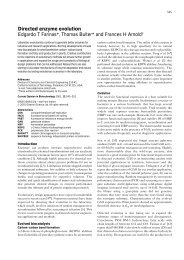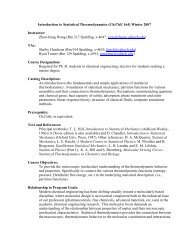Protein evolution - Department of Chemical Engineering - Caltech
Protein evolution - Department of Chemical Engineering - Caltech
Protein evolution - Department of Chemical Engineering - Caltech
- No tags were found...
Create successful ePaper yourself
Turn your PDF publications into a flip-book with our unique Google optimized e-Paper software.
<strong>Protein</strong> <strong>evolution</strong>NICOLAS PUTMAN / UC BERKELEYteam traced in detail how <strong>evolution</strong>tweaked the ancestral structure overtime to yield new functions.They found that in many receptorlineages, a few mutations subtlychanged the size and shape <strong>of</strong>the cavity where the signallingcompound binds, causing receptorsto evolve partnerships withhormones or other new signals.Other members <strong>of</strong> the receptorfamily became independent <strong>of</strong>chemical signals; these proteins, likeswitches stuck in the ‘on’ position,evolved when simple mutationsincreased the intrinsic stability <strong>of</strong>the protein’s active conformation,removing the need for a chemicalsignal to activate gene expression.Ancestral complexity‘If you just compare the receptors inmodern humans, the <strong>evolution</strong>aryevents by which they could haveevolved are not obvious. It may lookas if the complex functions <strong>of</strong> eachprotein evolved independently,’ saysThornton. ‘But when we traced theseproteins from their ancestor throughtime, we saw how <strong>evolution</strong> tinkeredwith the ancestral form, producingan incredible diversity <strong>of</strong> proteinfunctions and the ability to interactwith many different chemical signals.’Nuclear receptors are a ‘greatcase study in protein <strong>evolution</strong>’,says Thornton, adding that it islikely that other protein families,when studied in similar detail,will turn out to have diversifiedby a similar kind <strong>of</strong> tinkering. ‘Wepredict that, when sufficient dataare gathered to allow detailed<strong>evolution</strong>ary reconstructions, itwill become apparent that mostprotein superfamilies diversifiedby subtle modification and partialdegradation <strong>of</strong> ancient, deeplyhomologous functions. Invoking the<strong>evolution</strong> <strong>of</strong> wholesale ‘‘novelty’’will seldom be necessary.’ 1That’s all very interesting, <strong>of</strong>course, but is it really useful? Verymuch so, Thornton explains:‘Structure-function relationships arethe fundamental object <strong>of</strong> knowledgein protein chemistry; they allow usto rationally design drugs, engineerproteins with new functions, andunderstand why mutations causedisease.’ Unfortunately, revealing howthe sequence <strong>of</strong> a protein determinesits function using traditionallaboratory manipulations is difficult,because the number <strong>of</strong> possiblesequence variations in any proteinfamily is too great. ‘The solution liesin studying <strong>evolution</strong>, which has beena massively parallel experiment indiversifying and optimising proteins,conducted over vast periods <strong>of</strong> time’says Thornton.One person who has found protein<strong>evolution</strong> both interesting anduseful is Frances Arnold, a chemicalengineer at California Institute <strong>of</strong>Technology (<strong>Caltech</strong>) in Pasadena,US. Arnold, together with Willem‘Pim’ Stemmer, chief executive <strong>of</strong> theCalifornian biopharmaceutical firmAmunix, has just been awardedthe Charles Stark Draper prize –widely considered the equivalent<strong>of</strong> the Nobel prize for engineeringin the US – for developingdirected <strong>evolution</strong>: ‘a methodused worldwide for engineeringNuclear receptor<strong>evolution</strong> has beentraced in the seaanemone N. vectensisand other species fromthe relatively distant<strong>evolution</strong>ary past<strong>Protein</strong>s with flexibleconformations, like thissugar-binding lectin, aremore likely to evolve awide variety <strong>of</strong> functionsnovel enzymes and biocatalyticprocesses for pharmaceutical andchemical products.’Inspired by the real-life <strong>evolution</strong><strong>of</strong> proteins, Arnold developed asystem that literally ‘directs’ the<strong>evolution</strong> <strong>of</strong> proteins by repeatedrounds <strong>of</strong> mutation and selection.‘Evolution happens by theaccumulation <strong>of</strong> beneficial mutationsone at a time through functionalproteins,’ says Arnold. ‘And that’sa very simple algorithm; it doesn’trequire that you screen large numbers<strong>of</strong> things if you can go through singlemutational stops.’Mimicking <strong>evolution</strong>Arnold began to evolve proteinsby randomly mutating the gene<strong>of</strong> a known protein, screening itsmutant <strong>of</strong>fspring a few-hundred or afew-thousand at a time, finding onebeneficial mutation, and repeatingthe process starting from that mutantgene. ‘That’s just mimicking howadaptive <strong>evolution</strong> happens,’ she says.‘It doesn’t fully mimic it, becausewe miss the entire neutral mutationpathways,’ she says, ‘but peopleare starting to try to insert neutralmutations into directed <strong>evolution</strong>as well.’ Neutral mutations will bepassed on from one generation tothe next if they pose no threat to anorganism’s survival. They shouldn’tbe ignored because, further on downthe line, they might help give rise to abeneficial mutation.Another important lesson fromadaptive, real-life, <strong>evolution</strong> has comefrom recognising which proteins andwhat functions are evolvable. ‘We’velearnt that the proteins that evolveDAN TAWFIK44 | Chemistry World | March 2011www.chemistryworld.org
NATIONAL LIBRARY OF MEDICINE / SCIENCE PHOTO LIBRARYreadily in nature also evolve readily inthe laboratory,’ says Arnold.‘For example, secondary metabolicpathway enzymes, like cytochromeP450s and other enzymes whosespecificities and functions havevaried all over the map tend to readilychange in the laboratory,’ she says.‘And the converse is true, proteinswhose functions have not showngreat diversity in nature tend to bemore difficult to engineer’Arnold comes from what she callsan engineering and problem solvingbackground. ‘I was looking for themost effective means to engineerproteins, the sequence basis <strong>of</strong> whosefunctions we just don’t understand.So a rational design pathway toachieve very specific functions justwasn’t realistic, and <strong>evolution</strong> seemedto be a much more promising route.’Just as Arnold keeps up with theworld <strong>of</strong> natural protein <strong>evolution</strong>,particularly work from Thornton’slab, protein <strong>evolution</strong>ists are nowreading the directed <strong>evolution</strong> work.‘We have one huge advantage,’ saysArnold, ‘and that’s data.’Although directed <strong>evolution</strong>started from an engineeringperspective, researchers fromdifferent backgrounds and interestshave come to it specifically to answerquestions about how proteinsevolve. ‘If you look at people likeJoe Thornton or a number <strong>of</strong>people whose primary interest is in<strong>evolution</strong>, they are now using directed<strong>evolution</strong> to try to understand howproteins can adapt,’ she says.The traditional view that proteinspossess absolute functional specificityand a single, fixed structure conflictswith their marked ability to adapt andevolve new functions and structures,says Dan Tawfik <strong>of</strong> the WeizmannInstitute <strong>of</strong> Science in Israel.‘Natural selection is yieldingmolecular machines withbreathtaking performance,’ saysTawfik. ‘New functions can evolvewithin years or even months, ashappens naturally with things likedrug resistance.’Tawfik’s team argues that proteinsexhibit ‘functional promiscuity’,which is an essential component <strong>of</strong> aprotein’s evolvability. He correlatespromiscuity with conformationaldiversity. In antibodies, for example,increased affinity for a ligand –clearly an essential characteristic<strong>of</strong> an antibody – leads to decreasedbinding-site flexibility. Converselythe P450s, as mentioned by Arnold,demonstrate increased promiscuity– relatively broad substrate scope –with increasing flexibility.But is it really chemistry?The study <strong>of</strong> protein <strong>evolution</strong> liesat the interface <strong>of</strong> chemistry andbiology, and relies to a large extenton engineering. Each discipline canclaim it as their own, but it is <strong>of</strong>tenChristian Anfinsenone <strong>of</strong> a host <strong>of</strong> proteinscientists who haveclaimed the Nobel prizefor chemistry‘Naturalselectionis yieldingmolecularmachines withbreathtakingperformance’dismissed as ‘not really biology’ or‘not really chemistry’.It’s definitely chemistry,says Arnold the engineer, whonevertheless files directed <strong>evolution</strong>firmly under ‘synthetic biology’.Apart from anything else, scientistshave a habit for winning Nobel prizesin chemistry for work on proteins.Back in 1946, the Nobel prize inchemistry went to James Sumner<strong>of</strong> Cornell University, US, who wonhalf the prize ‘for his discovery thatenzymes can be crystallised’; andJohn Northrop together with WendellStanley, both <strong>of</strong> the RockefellerInstitute for Medical Research inPrinceton, US, shared the other half‘for their preparation <strong>of</strong> enzymes andvirus proteins in a pure form’.In 1972, half the chemistry Nobelprize went to Christian Anfinsen<strong>of</strong> the US National Institutes <strong>of</strong>Health with the other half shared byStanford Moore and William Stein,both from Rockefeller Universityin New York, US, for fundamentalwork in protein chemistry. Anfinsenhad shown that the information fora protein assuming a specific threedimensionalstructure is inherentin its amino acid sequence, whichwas the starting point for studies<strong>of</strong> protein folding. Moore and Steinreceived the prize for discoveringanomalous properties <strong>of</strong> functionalgroups in an enzyme’s active site, as aresult <strong>of</strong> the protein fold.In 2009, the prize went toVenkatraman Ramakrishnan, ThomasSteitz and Ada Yonath ‘for studies<strong>of</strong> the structure and function <strong>of</strong> theribosome’. In 2008 it was awardedjointly to Osamu Shimomura, MartinChalfie and Roger Tsien ‘for thediscovery and development <strong>of</strong> thegreen fluorescent protein, GFP’.On Frances Arnold’s website, 3 teammembers have contributed to a ‘Howwould you explain synthetic biologyto Darwin?’ section.In Arnold’s words: ‘You had itjust right! And now I can build newcomponents <strong>of</strong> life – for example,the proteins <strong>of</strong> which we are made– by artificial selection. When Idecide who gets to reproduce,these components evolve just likethe organisms that make them do,because they are encoded by the samestuff and follow the same principles<strong>of</strong> <strong>evolution</strong> that you showed usfor all forms <strong>of</strong> life.’References1 J T Bridgham et al, PLoS Biol., 2010, 8,e1000497, (DOI: 10.1371/journal.pbio.1000497)2 N Tokuriki and D S Tawfik, 2009, Science,324, 2033 www.che.caltech.edu/groups/fhawww.chemistryworld.org Chemistry World | March 2011 | 45



